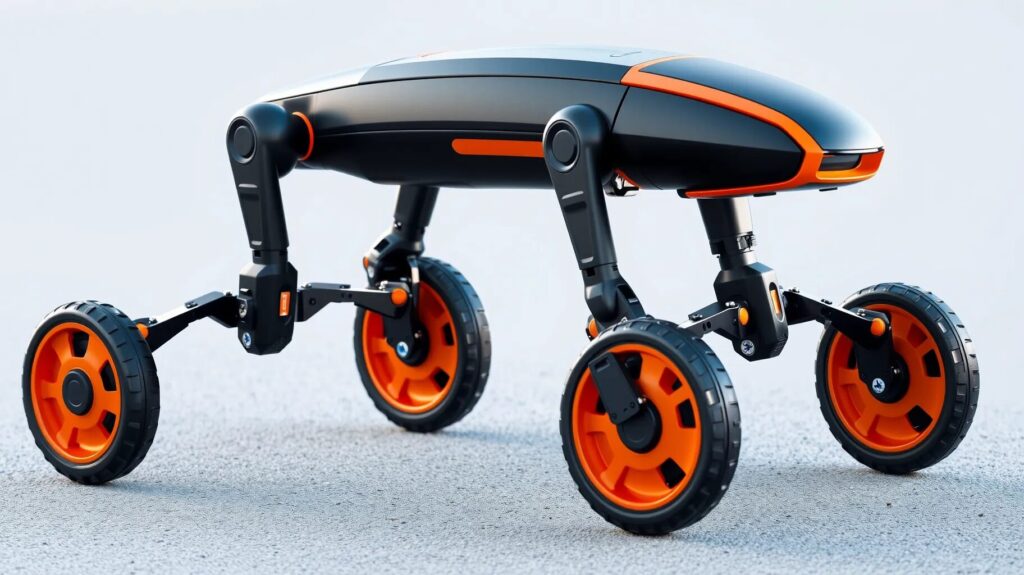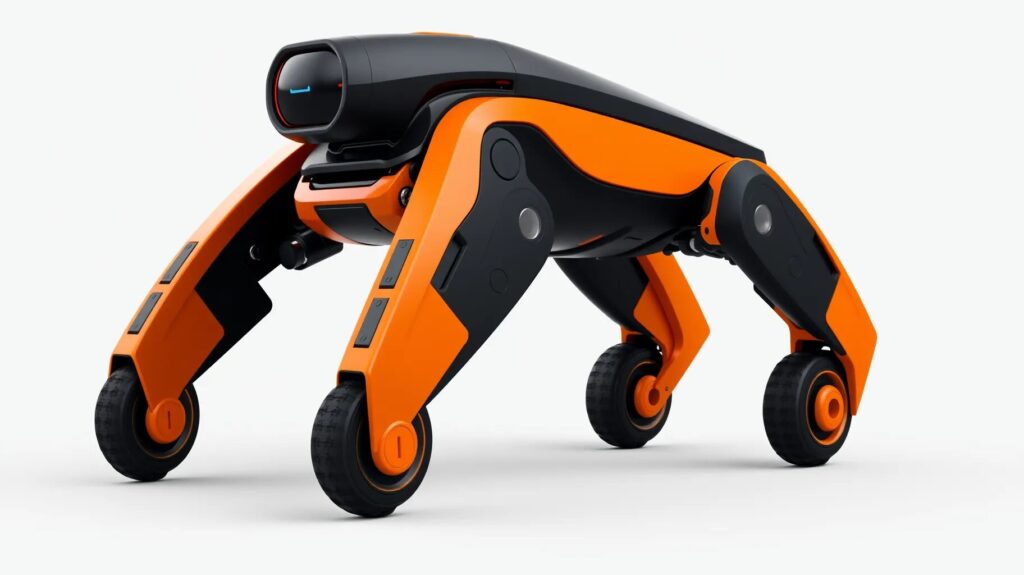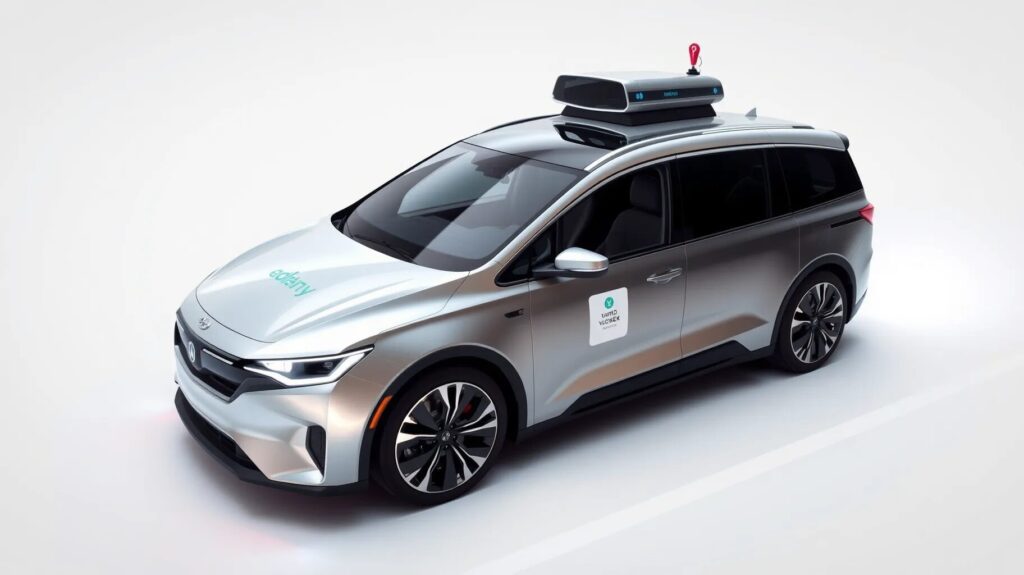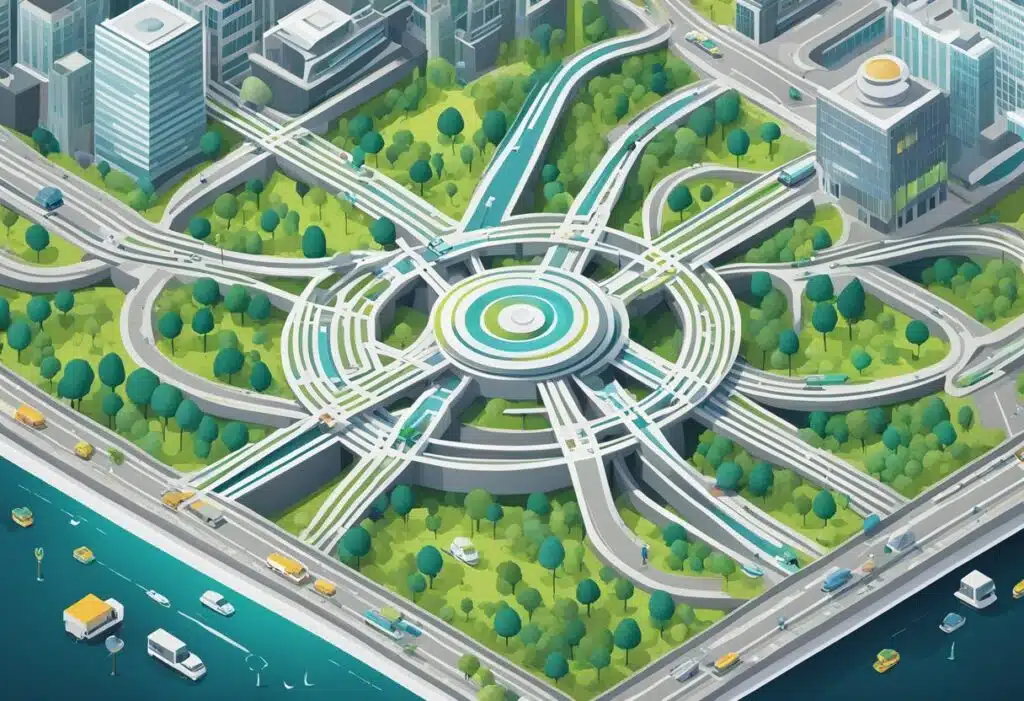
Rise of Autonomous Vehicles: A Glimpse into the Future
Imagine waking up in the near future. The streets are no longer filled with the noisy, smoke-belching cars of the past, but rather a quiet stream of sleek, four-wheeled robots zipping through the lanes. These aren’t the robots of science fiction, but real, tangible vehicles designed to transform urban transportation as we know it.
Autonomous vehicles (AVs) are not just a concept; they are swiftly becoming a reality. From Google’s self-driving cars to Tesla’s Autopilot, the march toward autonomy is well underway. Yet, the leap from highways to crowded city streets presents a whole new set of challenges. How do we prepare our cities for these changes, and more importantly, how do these robots fit into our daily lives?
Urban Mobility Redefined: How Cities Are Adapting
Cities are dynamic organisms—constantly evolving to meet the needs of their inhabitants. As AVs become more common, urban landscapes must adapt. This transformation is already visible in smart city initiatives around the globe. These projects are rethinking traffic management, parking solutions, and pedestrian safety, all through the lens of an autonomous future.
Imagine a city where traffic lights communicate directly with vehicles, optimizing the flow and reducing congestion. Parking lots shrink in size, or disappear entirely, as shared autonomous vehicles reduce the need for personal car ownership. Public spaces expand, reclaiming what was once asphalt for parks, walking paths, and communal areas.
But adapting to this new reality isn’t just about infrastructure; it’s also about mindsets. As we’ll explore, public perception plays a critical role in the acceptance of these four-wheeled robots.
Four-Wheeled Robots: The Backbone of Future Transport?

The humble automobile is on the brink of a radical transformation. What was once a tool for personal freedom is quickly morphing into an integral part of the urban mobility network. These four-wheeled robots are not just cars without drivers; they are smart, connected entities that can navigate complex city environments, communicate with each other, and make decisions in real-time.
The potential benefits are immense. Reduced traffic congestion, lower emissions, and a significant drop in road accidents are just the tip of the iceberg. Autonomous vehicles could also offer mobility solutions for those who are unable to drive, such as the elderly or disabled, creating a more inclusive urban environment.
Yet, the success of this transformation hinges on more than just the technology itself. Public trust, regulatory frameworks, and economic considerations will all play a crucial role in determining whether these robots truly become the backbone of future transportation.
Sustainability and Efficiency: The Dual Benefits of Autonomous Vehicles
In the era of climate consciousness, sustainability is more than a buzzword—it’s a necessity. Autonomous vehicles (AVs) offer a unique opportunity to enhance both environmental sustainability and transportation efficiency. Unlike traditional vehicles, AVs can be optimized for fuel efficiency, minimizing wasteful driving behaviors such as idling and sudden acceleration.
Furthermore, these four-wheeled robots are often designed to run on electric power, drastically reducing carbon emissions. As more cities and countries commit to reducing their carbon footprints, AVs could play a pivotal role in achieving these ambitious goals. The ability of AVs to navigate and optimize routes using real-time data also means that traffic congestion—a significant source of urban pollution—could be greatly alleviated.
But efficiency isn’t just about fuel consumption. It’s also about time. With AVs, we could see the dawn of a world where traffic jams are a thing of the past, thanks to vehicles that communicate with each other and the infrastructure around them, ensuring smooth and efficient travel. Imagine a city where traffic is always moving, where commutes are not just faster, but also more predictable.
Public Perception: Are We Ready to Trust Robots on the Roads?
As with any new technology, public perception is a critical factor in the adoption of autonomous vehicles. The idea of four-wheeled robots zipping around city streets might sound thrilling to some, but unsettling to others. Trust is the cornerstone of widespread adoption, and building that trust requires addressing both rational and emotional concerns.
Many people worry about the safety of autonomous vehicles. Can a machine truly be trusted to make split-second decisions in the chaotic environment of a city street? What happens if something goes wrong? These are valid concerns that must be addressed through rigorous testing, transparent communication, and real-world demonstrations of the technology’s capabilities.
There’s also the question of control. For over a century, driving has been a deeply personal experience, symbolizing freedom and autonomy. Handing over the steering wheel to a robot requires a cultural shift, one that’s already beginning to take root in younger generations who prioritize convenience and efficiency over the traditional driving experience.
Regulatory Hurdles: What Needs to Change for Widespread Adoption
While the technology for autonomous vehicles is rapidly advancing, the regulatory landscape is still catching up. Governments around the world are grappling with how to integrate these new technologies into existing legal frameworks. This involves rethinking everything from insurance policies to traffic laws.
One of the key challenges is defining liability. In a world where accidents do happen, who is responsible when a self-driving car is involved? The manufacturer, the software developer, or the owner? These are complex legal questions that need clear answers before AVs can become a mainstream option.
Moreover, there is a need for standardization. With different companies developing their own versions of AV technology, there’s a risk of fragmentation. Governments and industry leaders must work together to create universal standards that ensure safety, interoperability, and fairness in the marketplace.
Regulations must also keep pace with technological advancements. As AVs become more capable, laws will need to evolve to allow for more autonomous functions. This is a delicate balance—moving too quickly could lead to safety risks, but moving too slowly could stifle innovation.
Innovative Technologies Powering Autonomous Urban Transport
At the heart of the autonomous vehicle revolution are groundbreaking technologies that enable these four-wheeled robots to navigate our cities safely and efficiently. From advanced sensors to artificial intelligence, these innovations are the driving force behind the transformation of urban transportation.
LIDAR (Light Detection and Ranging), for instance, is a critical technology that allows AVs to create detailed 3D maps of their surroundings. By sending out laser beams and measuring how long they take to return, LIDAR systems can detect obstacles, pedestrians, and other vehicles with remarkable accuracy, even in challenging conditions like fog or heavy rain.
Machine learning algorithms are equally vital, enabling AVs to interpret the vast amounts of data they collect and make real-time decisions. These algorithms are trained on countless hours of driving data, allowing the vehicles to recognize patterns, predict behaviors, and adapt to new situations. As these systems continue to evolve, AVs will only become more adept at handling the complexities of urban environments.
Additionally, V2X (Vehicle-to-Everything) communication allows autonomous vehicles to interact not just with other vehicles, but with traffic lights, road signs, and even pedestrians. This interconnected network could lead to a more coordinated and efficient traffic system, where vehicles can anticipate and respond to changes in traffic flow almost instantaneously.
Impact on the Economy: Jobs, Industry, and Infrastructure
The rise of autonomous vehicles is set to have a profound impact on the global economy, reshaping industries and altering job markets. While the transition to AVs promises numerous benefits, it also presents challenges that society must navigate carefully.
One of the most immediate effects will be on the transportation industry. As AVs become more prevalent, the demand for traditional drivers—whether in trucking, taxis, or public transportation—could decline significantly. This raises important questions about how to support workers who may find their skills becoming obsolete. Reskilling programs and new employment opportunities in technology, maintenance, and urban planning will be essential to ensure that this transition is as smooth as possible.
The automotive industry itself will also undergo significant changes. As the focus shifts from traditional car manufacturing to the development of autonomous technology, companies will need to innovate or risk being left behind. This shift could lead to new collaborations between tech companies and automakers, as well as the emergence of startups specializing in AV software, sensors, and related technologies.
Moreover, the widespread adoption of AVs will require significant investments in infrastructure. Cities will need to upgrade roads, traffic management systems, and communication networks to accommodate these new vehicles. While these investments may be costly upfront, the long-term benefits in terms of reduced congestion, lower emissions, and improved safety could more than justify the expense.
Safety First: How Autonomous Vehicles Aim to Reduce Accidents
One of the most compelling arguments for the adoption of autonomous vehicles is their potential to dramatically improve road safety. Human error is a leading cause of traffic accidents, and AVs have the potential to reduce these errors significantly.
Autonomous vehicles are designed to follow the rules of the road with absolute precision. They don’t get distracted, tired, or impaired, and they can react to potential hazards faster than any human driver. With the help of advanced sensors and AI, these vehicles can detect and respond to obstacles, pedestrians, and other vehicles with unparalleled accuracy.
In addition to avoiding accidents, AVs can also communicate with each other to prevent collisions before they even happen. For instance, if one vehicle suddenly stops, nearby AVs can be alerted instantly, allowing them to take action and avoid a pile-up. This level of inter-vehicle communication could significantly reduce the number of multi-car accidents, making roads safer for everyone.
However, ensuring safety isn’t just about avoiding accidents—it’s also about preparing for the unexpected. Developers are working on making AVs not only better drivers but also better at handling emergencies. This involves programming vehicles to recognize and respond to unusual situations, such as a child running into the street or an unexpected road closure. These efforts aim to make autonomous vehicles not just as safe as human drivers, but far safer.
Environmental Impact: The Green Potential of Robot Cars

As climate change concerns intensify, the environmental impact of transportation is under scrutiny like never before. Autonomous vehicles offer a promising path toward a greener future, particularly as they align with the growing trend toward electrification. These four-wheeled robots have the potential to drastically reduce urban pollution, thanks to their efficiency and electric powertrains.
One of the most significant environmental benefits of AVs is their potential to reduce carbon emissions. Traditional vehicles contribute a substantial portion of urban air pollution, particularly in densely populated cities. However, many autonomous vehicles are being designed with electric propulsion systems, which produce zero tailpipe emissions. As the global energy grid continues to shift towards renewable sources, the environmental footprint of these vehicles will shrink even further.
In addition, AVs can optimize driving patterns to minimize energy consumption. By maintaining steady speeds, avoiding unnecessary stops, and optimizing routes in real-time, they can significantly cut down on the fuel—or in this case, electricity—used for each trip. This not only reduces emissions but also lowers overall energy demand, making urban transportation more sustainable.
Moreover, the shift to autonomous vehicles could accelerate the transition to shared mobility. With AVs operating in fleets, the need for personal car ownership could decrease, leading to fewer vehicles on the road. This reduction in vehicle numbers would not only lower emissions but also reduce the environmental costs associated with car manufacturing and disposal.
Challenges in Implementation: What Could Go Wrong?
While the potential benefits of autonomous vehicles are substantial, the path to their widespread adoption is fraught with challenges. These challenges must be carefully navigated to ensure that the transition to autonomous urban transportation is both safe and effective.
One of the primary concerns is the technical reliability of AVs. Although the technology has made impressive strides, it is still not perfect. Autonomous vehicles must be able to handle a wide range of driving conditions, from inclement weather to unpredictable human behavior. Ensuring that these vehicles can operate safely in all scenarios is a daunting task, requiring ongoing testing and development.
Cybersecurity is another significant challenge. As AVs rely heavily on software and connectivity, they are vulnerable to hacking and other cyber threats. A successful cyberattack on an autonomous vehicle could have catastrophic consequences, potentially leading to accidents or disruptions in transportation networks. To mitigate these risks, robust security measures must be implemented, and constant vigilance is required to protect against evolving threats.
The cost of implementing autonomous vehicles on a large scale is also a significant hurdle. Developing, producing, and maintaining AVs is expensive, and the necessary infrastructure upgrades—such as smart traffic systems and charging stations—will require substantial investment. Additionally, the public and private sectors must collaborate closely to ensure that these investments are made in a way that benefits society as a whole.
Finally, there is the challenge of public acceptance. While many people are excited about the prospect of autonomous vehicles, others are skeptical or fearful. Concerns about safety, job displacement, and loss of personal control over driving are all barriers to widespread acceptance. Addressing these concerns through education, transparent communication, and demonstrated safety improvements will be crucial for the successful integration of AVs into urban life.
Global Case Studies: Cities Leading the Autonomous Revolution
Around the world, cities are experimenting with autonomous vehicles, providing valuable insights into how this technology might shape urban transportation in the future. These pioneering efforts offer a glimpse into what the autonomous revolution could look like on a global scale.
In the United States, Phoenix, Arizona has become a testing ground for Waymo, Google’s self-driving car project. With its clear skies and well-maintained roads, Phoenix offers ideal conditions for AV testing. Waymo’s vehicles have been operating in the city for several years, providing rides to local residents and collecting vast amounts of data to improve the technology. The city’s experience with AVs could serve as a model for other urban areas looking to embrace this technology.
Across the Atlantic, Helsinki, Finland is also making strides in autonomous transportation. The city has launched several pilot projects, including autonomous buses that navigate the city’s streets. These trials are part of Helsinki’s broader plan to create a more sustainable and efficient transportation system, one that relies less on private car ownership and more on shared, autonomous services.
In Asia, Singapore is at the forefront of the autonomous vehicle movement. The city-state’s government has been proactive in supporting AV development, establishing dedicated test zones and creating a regulatory framework that encourages innovation. Singapore’s dense urban environment presents unique challenges, but its commitment to becoming a leader in smart transportation could make it a blueprint for other cities in the region.
These global case studies highlight the potential of autonomous vehicles to revolutionize urban transportation, but they also underscore the importance of tailoring solutions to the specific needs and conditions of each city. As more cities around the world experiment with AVs, we’ll gain a clearer understanding of how to best implement this technology on a broader scale.
The Role of AI and Machine Learning in Autonomous Navigation
At the core of autonomous vehicles is the powerful combination of artificial intelligence (AI) and machine learning. These technologies enable AVs to navigate complex urban environments, making split-second decisions that mimic human judgment—but with greater precision and reliability. Understanding how AI and machine learning contribute to autonomous navigation is key to appreciating the sophistication behind these four-wheeled robots.
AI algorithms in AVs are responsible for processing vast amounts of data from sensors, cameras, and other inputs to understand the vehicle’s surroundings. This involves recognizing objects, predicting the behavior of other road users, and determining the safest and most efficient route to the destination. For instance, when an autonomous vehicle approaches a busy intersection, AI analyzes the movements of pedestrians and other vehicles to decide when to stop, go, or yield.
Machine learning takes this a step further by allowing the vehicle to learn from past experiences. Through deep learning techniques, AVs can improve their performance over time, adapting to new scenarios that weren’t explicitly programmed. For example, after encountering a certain type of obstacle multiple times, the vehicle becomes better at predicting and responding to similar situations in the future. This continuous learning process is what makes autonomous vehicles increasingly reliable as they spend more time on the road.
Moreover, machine learning enables predictive analytics, which can foresee potential risks and adjust the vehicle’s behavior accordingly. If an AV detects a slippery road ahead due to rain, it can slow down preemptively or choose an alternate route, reducing the likelihood of an accident. This proactive approach to driving is one of the key advantages of autonomous technology, potentially making roads safer for everyone.
Public Transportation vs. Private Ownership: A Shift in Paradigm?
As autonomous vehicles become more integrated into urban environments, we may witness a significant shift in how people approach transportation. One of the most profound changes could be the move from private car ownership to a more public, shared model of transportation. This paradigm shift has the potential to reshape cities, economies, and the very way we think about mobility.
The traditional model of each household owning one or more vehicles could give way to shared autonomous fleets. These fleets, operated by ride-hailing services or public transit agencies, would be available on-demand, offering a convenient and cost-effective alternative to owning a car. This model not only reduces the number of vehicles on the road, easing congestion, but also makes transportation more accessible to a wider range of people, including those who cannot drive due to age, disability, or financial constraints.
For public transportation systems, autonomous vehicles offer an opportunity to fill gaps in service and enhance efficiency. Autonomous shuttles could operate in areas where traditional bus routes are not cost-effective, or they could provide first-mile/last-mile solutions, connecting commuters from their homes to major transit hubs. By complementing existing public transport, AVs could create a more integrated and seamless transportation network, making it easier for people to navigate cities without the need for a personal vehicle.
However, this shift towards shared, autonomous transportation raises questions about privacy, convenience, and the cultural attachment to personal car ownership. Many people value the freedom and control that comes with having their own vehicle. The transition to a shared model will require not just technological innovation, but also cultural and societal changes. It’s a challenge that involves rethinking how we prioritize convenience, efficiency, and sustainability in our daily lives.
Future Scenarios: What Will Urban Transport Look Like in 2050?
Peering into the future, we can imagine a world where urban transportation is almost unrecognizable from what we know today. By 2050, autonomous vehicles could be as common as smartphones, fundamentally altering how cities function and how people move within them. What might this brave new world of transportation look like?
In this future, the concept of traffic as we know it might become obsolete. With AVs coordinating with each other and city infrastructure, traffic jams could be a thing of the past. Roads would be optimized for autonomous vehicles, with lanes dynamically adjusting based on real-time demand and priority given to shared vehicles during peak hours. The urban landscape itself could change, with fewer parking lots and more green spaces, as the need for personal cars diminishes.
Public transit could evolve into a highly flexible, on-demand service, where autonomous buses and shuttles pick up passengers exactly when and where they need to be. Commuters might subscribe to mobility services that provide seamless access to a range of transportation options, from bike-sharing and scooters to AVs and high-speed trains—all coordinated through a single app. This integrated approach would make commuting faster, cheaper, and more convenient than ever before.
Moreover, the environmental impact of urban transport could be drastically reduced. With the widespread adoption of electric AVs, cities could see a significant drop in air pollution and greenhouse gas emissions. Streets might be quieter, cleaner, and safer, with fewer accidents and more space for pedestrians and cyclists.
However, the success of this future depends on how well society addresses the challenges of today—regulations, public acceptance, infrastructure investment, and ethical considerations. If these hurdles are overcome, the cities of 2050 could be more livable, sustainable, and connected than ever imagined.
Human-Centered Design: Ensuring Accessibility for All
As we look toward a future dominated by autonomous vehicles, it’s crucial to ensure that human-centered design remains at the forefront of this technological revolution. For AVs to truly transform urban transportation, they must be accessible and usable for everyone, regardless of age, ability, or socioeconomic status.
Inclusive design means that autonomous vehicles must accommodate a wide range of users, including those with disabilities. This could involve features like voice-activated controls, adjustable seating for ease of access, and built-in assistance for those with visual or hearing impairments. Additionally, vehicles should be designed with ample space for wheelchairs or other mobility aids, ensuring that individuals with physical disabilities can use them independently.
Beyond physical accessibility, the user interface of AVs must be intuitive and user-friendly. People of all ages and tech-savviness should feel comfortable using autonomous vehicles. This means creating interfaces that are simple, clear, and adaptable to the needs of different users. For instance, elderly passengers might prefer larger text and voice guidance, while younger users might favor smartphone integration and touch-based controls.
Moreover, the concept of equitable access must be considered. Autonomous transportation should not be a luxury available only to those who can afford it, but a service that is accessible to all segments of society. This could be achieved through government subsidies, public-private partnerships, or community-based initiatives that ensure AVs are affordable and widely available, especially in underserved areas.
The Ethical Dilemma: Who’s Responsible When Robots Fail?
The rise of autonomous vehicles brings with it a host of ethical dilemmas that society must grapple with, chief among them being the question of responsibility when something goes wrong. In a world where machines make decisions on our behalf, who is held accountable when those decisions lead to harm?
One of the most complex ethical issues revolves around the “trolley problem” in the context of autonomous vehicles. Imagine an AV is faced with an unavoidable accident scenario where it must choose between two equally tragic outcomes—hitting a pedestrian or swerving and risking the lives of its passengers. How should the vehicle be programmed to respond, and who decides this? These moral decisions, once the purview of human drivers, now need to be codified into algorithms, raising uncomfortable questions about the values we prioritize.
Another significant concern is liability. In the event of an accident involving an autonomous vehicle, determining who is at fault becomes complicated. Is it the manufacturer, the software developer, the vehicle owner, or the passengers? This ambiguity has far-reaching implications for insurance policies, legal frameworks, and even the development of the technology itself. Establishing clear guidelines and regulations is crucial to resolving these issues and ensuring that victims can receive compensation without prolonged legal battles.
Moreover, the ethical considerations extend beyond just accidents. The data collected by autonomous vehicles, including location tracking, driving habits, and even passenger behavior, poses privacy concerns. Who owns this data, how is it used, and what safeguards are in place to protect individuals’ privacy? These are critical questions that need to be addressed to build public trust in autonomous vehicles.
Human Oversight: The Role of Humans in an Autonomous World
Even as autonomous vehicles take on more responsibilities, human oversight will remain an essential component of the system. Although AVs are designed to operate independently, there will still be situations where human intervention is necessary, especially in complex or unexpected scenarios.
One area where human oversight is critical is in the monitoring and maintenance of autonomous vehicle fleets. While AVs can perform self-diagnostics and even minor repairs, human technicians will be needed to handle more complex issues, ensuring that vehicles remain safe and functional. Additionally, human operators may be required to monitor AVs remotely, ready to step in if the vehicle encounters a situation it cannot handle on its own.
Moreover, the role of human decision-making will continue to be important in areas like policy-making, ethical considerations, and system design. Humans will be responsible for setting the guidelines and parameters within which AVs operate, ensuring that these systems reflect societal values and priorities.
In the broader context of urban planning and transportation management, humans will still play a crucial role in integrating AVs into the existing infrastructure, balancing the benefits of autonomy with the needs of other road users, such as pedestrians and cyclists. While AVs will change the landscape of urban transportation, the human element will remain indispensable, guiding the development and deployment of this transformative technology in a way that serves the greater good.
Conclusion: Steering Towards a Smarter, Safer, and More Sustainable Future
The advent of autonomous vehicles marks a transformative moment in the history of urban transportation. As four-wheeled robots begin to take over our streets, we stand on the brink of a new era—one where mobility is redefined, and the way we interact with our cities is fundamentally altered.
Sustainability, efficiency, and safety are just the beginning of the benefits that AVs promise to deliver. From reducing carbon emissions to minimizing traffic accidents, the potential of autonomous vehicles to create cleaner, safer, and more livable cities is immense. However, realizing this future requires navigating a complex landscape of technical challenges, ethical dilemmas, and regulatory hurdles.
Public acceptance will play a pivotal role in this transition. Building trust through transparency, rigorous testing, and thoughtful regulation is essential. Equally important is ensuring that this technology is inclusive and accessible, so that all segments of society can benefit from the advancements in urban mobility.
The future of autonomous urban transportation is not just about the technology itself, but about how we, as a society, choose to shape and integrate it into our lives. By prioritizing human-centered design, addressing ethical concerns, and maintaining a role for human oversight, we can steer towards a future where autonomous vehicles enhance our cities, making them smarter, safer, and more sustainable for everyone. As we look ahead, the question is not whether four-wheeled robots are the next big thing, but how we can ensure they become a positive force for change in our increasingly urban world.





